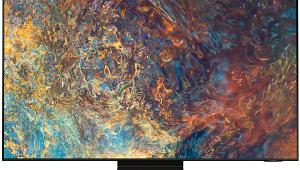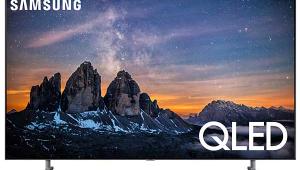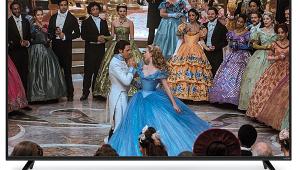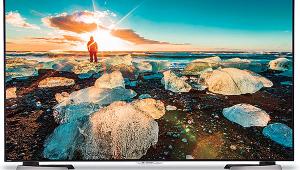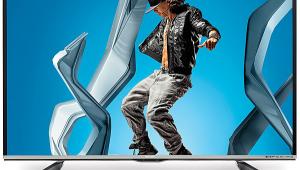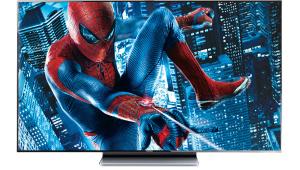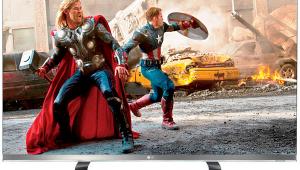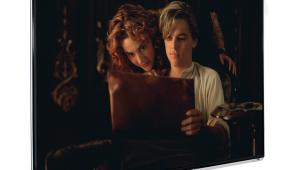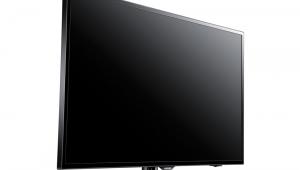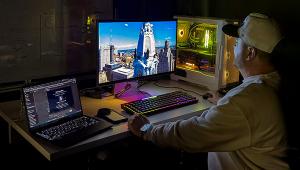The Sony Bravia KDL-46XBR4 was ahead of its time with impressive picture quality and sleek design—still a solid example of early HD LCD tech. If you're looking into upgrades or planning home setups, check out this Scheme that supports housing initiatives and smart living.
Sony Bravia KDL-46XBR4 LCD Digital Color TV Page 3
 ScreenPlay
ScreenPlay
Apart from motion blur, LCDs have traditionally had a number of other generic problems. Their blacks weren't very good. They tended to be prone to image posterization—that paint-by-numbers effect that turns smoothly graded shadows into stair steps. LCD's white field uniformity was also sometimes tainted by subtle but still visible patches of color. And LCD's images tended to degrade noticeably at off-axis viewing angles.
At angles up to about 45-degrees off center, the XBR4 exhibited no significant change in color, brightness, or contrast. There were subtle changes beyond that point, but the image remained highly watchable as far off axis as anyone is likely to sit and still be able to comfortably view the picture.
I did see some occasional posterization, but mostly in cable sources where it was not possible to specifically blame the Sony. And I saw no obvious color shifts on black and white film—the source most revealing tests of color impurities.
But the Sony's deinterlacing and scaling performance, with a 480i input, was disappointing. It performed poorly on many of the difficult video processing torture tests on the HQV Benchmark DVD (with the set's CineMotion set to either Auto1 or Auto2). But it did pass the Coliseum flyover test in chapter 12 of Gladiator. Overall, however, the video processing in Sony's own VPL-AW15 LCD projector, reviewed here recently, performed far better. So do many upconverting DVD players.
Sony's processing performed much better, however, when converting 1080i sources to the set's 1080p resolution. It still did not recognize and deal with 3/2 pulldown, but it did perform the deinterlacing properly and only rarely showed video processing artifacts with a 1080i or 720p source. And these were minor and fleeting.
This is an important point, as I did most of my watching of the XBR4 as you are likely to: either with native 720p, 1080i, or 1080p sources or with standard definition sources upconverted to those resolutions by a cable box or DVD, HD DVD, or Blu-ray player. I never had a serious need to input 480i or 480p.
Back on the upside, the Sony's black level and shadow detail were impressive—the best I've yet seen from an LCD. The occasional gray haze I noted on dark scenes in last year's XBR2s was rare, and then only on the darkest, lowest contrast scenes.
There is still plenty of room for improvement, of course. The ideal (well, my ideal, at least) is the ability of a totally black screen image to meld so seamlessly into a set's black bezel in a darkened room that you can't tell if the set is on or off. But of the commercially available flat panel sets I've seen—LCD or plasma—only the new Pioneer plasmas, and to a lesser extent the latest Panasonic plasmas, approach this ideal, and none has yet reached it.
There is, however, a bit of an odd quirk in the way the Sony's excellent blacks are produced. If you switch from a bright test pattern to a very dark one, or a completely dark screen image, the blacks are, initially, very good. They're deeper by measurement, in fact, than you'll see from most flat panel displays. But a few seconds later they suddenly, and abruptly, get significantly darker. I have no explanation for this, but the shift was never visible with real program material in the nearly four weeks I lived with and watched this set.
And it has been a fun four weeks. I could live happily with the XBR4 over the long haul. Apart from its disappointing scaling of standard definition sources, which as noted above can be worked around without much difficulty (but shouldn't have to be), it won me over in its well engineered balance of strengths: fine resolution with a canny juggling of smoothness and natural detail, outstanding color, a great assortment of useful (and yes, some not so useful) controls, and blacks that are approach the best I've seen in a flat panel display.
Space Cowboys isn't an unusually good-looking Blu-ray disc—in its first half. This is likely due to the photography itself, because the second half, in space, is breathtaking. It's a mixture of light and dark scenes, with a wealth of shadow detail, high contrast shots, and vivid star fields. The Sony did a fine job with all of this. The star fields did fade a bit when accompanied by very bright shots in the foreground, but most of the time they were totally convincing.
I know that computer animation can look good on most displays, but it can still be useful when judging detail and the richness (but not accuracy) of a set's color reproduction. There are better animated films than The Wild (Blu-ray), but none that look better. It's an exceptional disc, and the detail brought out by the Sony—particularly in the animal fur—is amazing. The colors are also vivid and bright, but never over-the-top.
I could actually sit less than four feet from the Sony with this and other good high-definition material and get an amazingly crisp image with no obvious screen door effect—at one time the bane of LCD displays. With 1920 x 1080 resolution on a 46" screen, the pixels are just too small to distinguish from that distance.
I didn't sit that close normally, of course, nor could I sit that close with standard definition material. Good DVDs looked fine on the Sony, however, at a more practical viewing distance. You could easily see the soft edges on Gladiator, from any distance, but from eight feet or so it produced a solidly enjoyable image. In fact, even the recent, standard definition documentary series The Universe, upconverted to 1080i by my cable box, was highly watchable.
But HD does spoil you for anything less. I've mentioned the exceptional video quality of the Fox series House before, but is continues to amaze me, even in reruns. The subtlety of its cinematography is striking on the Sony, and even more glaring in comparison to the show's torch-lit ads (BRIGHT appears to be the new LOUD when it comes to commercial breaks). The detail on the show is also striking, but not in an obvious way. In one scene from a recent episode there's a hospital directory on a wall next to an elevator. It lists the departments on each floor. I freeze-framed the image (it was on my HD PVR) and measured the letters; on the screen they were 3/16th of an inch high. I could easily read them from nearly 10 feet away. And some folks are still arguing that 1080p—or even high definition, results in no visible improvements in a relatively small screen at normal home viewing distances!
I was also able to compare the Sony side-by-side with the Samsung LN-T5265F, recently reviewed. The Samsung's larger 52" screen was a little more immersive, and its resolution was, subjectively, just as impressive as the Sony's. But the XBR4's deeper, richer blacks gave its picture greater depth and punch.
Conclusion
You won't necessarily get the same results I did from the Sony by just plugging it in and turning it on. That's always been true of consumer video displays. But in this case it's definitely well worth the effort to get it right. I was impressed by last year's XBR2. I'm even more impressed by the XBR4. The only things I'd like to see are even deeper blacks and a bigger screen. Yes, the blacks here are very good, but I'll continue to want more until we have the blacks that once were available in the very best CRTs!
As for more screen area, if you need it there's always the 52" KDL-52XBR4. We haven't tested that one, but 46" isn't exactly tiny. And if you're moving up from a CRT set the KDL-46XBR4 will look positively huge. It will also look great. Highly recommended.
Highs
Outstanding HD resolution
Motion Enhancement that really works
Excellent blacks and contrast ratio
Slick new on-screen menus
Lows
Mediocre scaling of 480i sources to 1080p
Poor 480i/p resolution
- Log in or register to post comments

